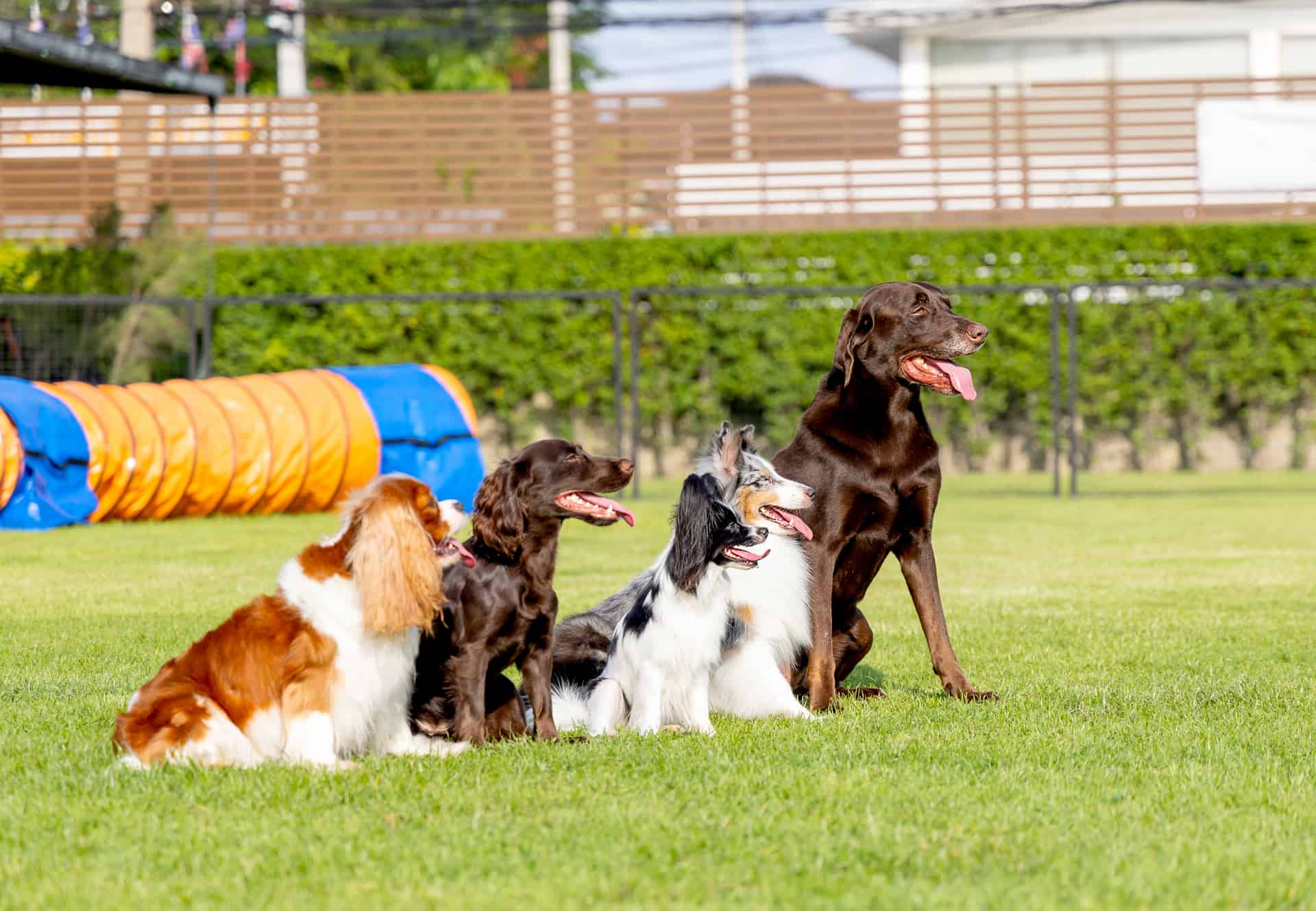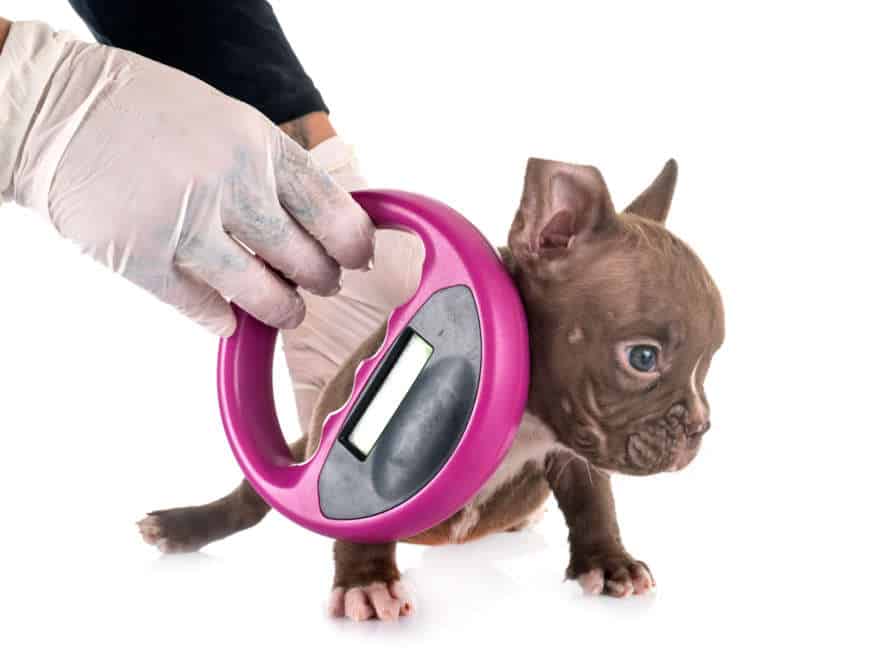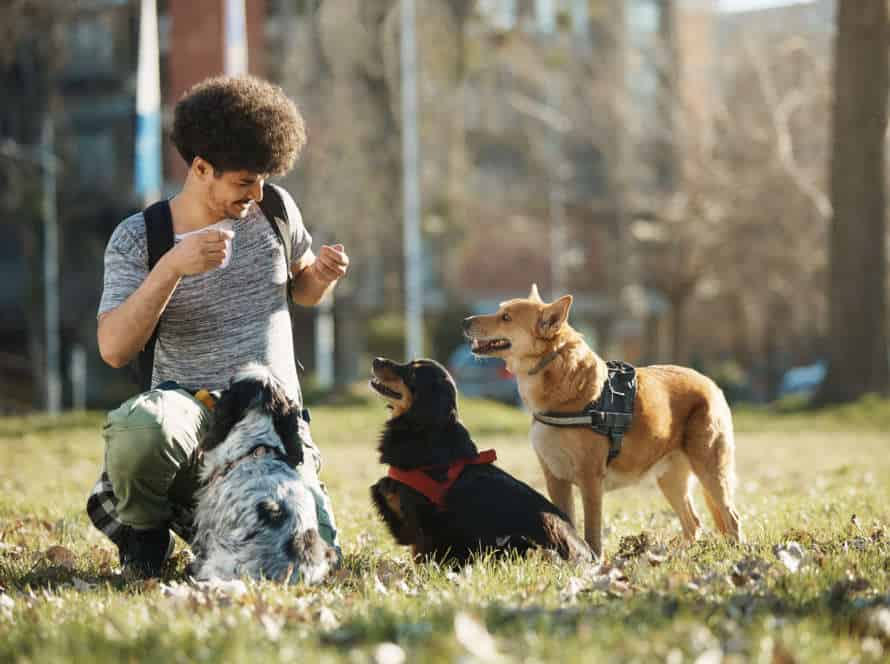Small Dog Syndrome: Prevention and Management
Small Dog Syndrome is a problem with small dogs that makes them act aggressive. Avoiding and managing this disorder is essential for a great relationship with your pup.
Here are some tips to avoid and handle Small Dog Syndrome:
- Socialize Early: Socialization is very important for a small dog’s growth. The more they get to be around different people, places, and dogs, the less likely they are to be aggressive.
- Consistent Training: Training helps you and your pup grow a strong bond. Your small dog should know their limits, obey you, and understand basic commands such as sit, stay, and come.
- Exercise: Regular exercise helps get rid of any energy that may cause bad behavior.
- Positive Reinforcement: Use treats and praises to reward good behavior, instead of punishing.
By following these steps, you and your pup can keep Small Dog Syndrome away, and have a beautiful relationship.
Understanding Small Dog Syndrome
Do you have a small pup? They may be suffering from “Small Dog Syndrome”. It’s a behavior problem which leads to aggression and anxiousness. To understand it, we’ll look at what causes this syndrome. Plus, how to manage it and stop it from happening again.
Small Dogs and Behavioral Issues
Small dogs are more likely than others to struggle with behavioural problems. This usually happens due to their size, or how they are treated.
If they’re treated like a baby or a possession, they can develop something called ‘Small Dog Syndrome’, which includes barking too much, biting, or being aggressive. To help prevent or manage the syndrome, here are some tips:
- Treat them like a dog, not a baby or a toy.
- Set rules for them and stick to them.
- Socialise them from a young age; introduce them to people, animals, and different places.
- Train them with positive reinforcement and no punishments.
- Give them exercise, mental stimulation, and playtime every day.
With patience and the right kind of training, Small Dog Syndrome can be prevented and managed.
Small Dog Syndrome Defined
Small Dog Syndrome is a condition when small dogs show aggressive or controlling behavior. Examples are barking too much, growling, biting and jumping on people or other animals.
To stop this, owners must start with proper training and socializing early. This includes obedience training, leash training and getting the dog used to other dogs and humans.
In addition, owners need to make sure they are in charge. Don’t let the bad behavior continue, like picking them up when they display aggression.
By following these steps, owners can stop Small Dog Syndrome and have a good relationship with their furry friends.
Causes of Small Dog Syndrome
Small Dog Syndrome is a set of behaviors that small dogs may display. This can cause them to be aggressive with people and bigger dogs. Its development could be due to many reasons, such as:
- Lack of teaching them how to behave properly. This makes them unable to understand commands or express their wants.
- Humans may reward their bad behavior which makes them think they are in charge.
- Fear and anxiety, which leads them to act aggressively to protect themselves.
- Health issues like ear or dental infections.
To manage and prevent Small Dog Syndrome, it’s important to socialize them early and train them consistently. Also, check for any medical issues and seek professional help if needed.
Identifying Small Dog Syndrome
Little Dog Syndrome – or “Small Dog Syndrome” – is a behavior found in small dogs. It’s often an aggressive or dominant behavior. Usually, they won’t listen and follow instructions. To keep your small dog calm and obedient, it’s important to spot this issue early and take the correct steps to manage it.
Aggressive Behaviors in Small Dogs
Small Dog Syndrome is a problem that can make small dogs behave aggressively. Signs of this include growling, biting, barking, being scared and guarding.
It’s important to take action if you think your small dog has it or is displaying aggressive behavior. Here are some tips to remember:
- Set clear rules for your pup.
- Socialize your dog when it’s young.
- Give them exercise and brain games.
- Get help from a vet or a behavior expert.
Remember that Small Dog Syndrome can be prevented, but it needs an owner that is devoted and is willing to give their pup the right training, socialization, and stimulation.
Fearful Behaviors in Small Dogs
Small Dog Syndrome is a group of behaviors seen in small dogs that are afraid and anxious around people, other dogs, or new places. Knowing these behaviors can stop Small Dog Syndrome and help small dogs.
Signs of Small Dog Syndrome:
- Growling and barking at strangers or other dogs
- Acting aggressive towards people or other dogs
- Always seeking attention and being too clingy
- Excessive barking or whining
- Shaking, hiding, or feeling nervous
To avoid Small Dog Syndrome, owners should give proper socialization and early training to small dogs. It’s important to set limits and use positive reinforcement for bad behavior. Furthermore, owners should provide a safe space for their dogs, supply mental and physical activities, and watch over their diet and health. With the right care and attention, small dogs can live a happy and healthy life.
Pro Tip: If you see any signs of Small Dog Syndrome, ask your vet or an experienced dog trainer for advice.
Other Behaviors Associated with Small Dog Syndrome
Small Dog Syndrome is a set of behaviors common in small breeds. It is caused by insecurity, anxiety, and overprotectiveness. Barking and aggressiveness are two examples.
Other behaviors include:
- Jumping on furniture/people.
- Urinating/defecating inside.
- Demanding attention/petting.
- Refusing to obey commands/rules.
- Being overly possessive.
If these behaviors go unchecked, it could be bad for the dog and people around them. To prevent/manage Small Dog Syndrome, owners should:
- Have a consistent training routine.
- Set boundaries/rules.
- Provide socialization/exercise.
- Show positive reinforcement, love and care.
This helps build confidence/trust.
Preventing Small Dog Syndrome
Small Dog Syndrome: a disorder seen in tiny pooches. Aggression, possessiveness and other bad habits can occur. But, there’s no need to worry! Here are some steps to avoid Small Dog Syndrome:
- Take preventive measures.
- Learn about the triggers.
- Make sure your pup gets plenty of exercise.
- Use positive reinforcement when training.
- Be consistent with your pup’s routine.
The Importance of Early Training and Socialization
Small Dog Syndrome is a behavioral issue. It often happens when early training and socialization of small breeds is absent. So, early training and socialization are super important.
Socialization should start from 3-4 weeks of age and continue until the pup is 6 months old. Introduce them to different sounds, smells, sights and textures. Make it a positive experience for them.
Training should begin too. Teach basic commands and use positive reinforcement. This helps to set up dominance and respect, plus helps build a strong relationship between you and your pup.
It’s never too late to start socializing and training your dog. Doing it in advance will save you from problems later.
Understanding Size and Breed Characteristics
Small Dog Syndrome is a problem caused by not giving small dogs the correct socialization and training. Knowing the size and breed of your small dog is vital to managing and stopping Small Dog Syndrome. Here are some tips:
- Know your dog’s breed. Each has special traits that affect their behavior. For instance, some small breeds bark more or need more exercise than others.
- Provide proper socialization. Let them experience different environments, people, and animals. This helps them adjust to new situations and avoids fear-based aggression.
- Be a leader. Small dogs require an owner who is strong and assertive. If not, they can become dominant and disobedient.
- Train them. Consistent training sets rules and rewards good behavior.
- Exercise them. Small dogs need daily activity to burn energy and reduce bad behavior caused by boredom.
By following these tips, you can prevent or manage Small Dog Syndrome.
Positive Reinforcement Training Techniques
Positive reinforcement training is a great way to help stop Small Dog Syndrome and manage it if it’s already present. Here are some techniques to try:
- Reward-based training. Give treats, praise, or positive attention when your pup does something you want them to do.
- Clicker training. This uses a clicking sound to let the dog know they did something right.
- Be consistent. Have a regular training routine and use the same commands each time.
- Socialize. Teach your pup how to interact with people and other animals from a young age.
In short, positive reinforcement training is a kind, effective way to prevent and manage Small Dog Syndrome.
Managing Small Dog Syndrome
Got a small pup? You may have Small Dog Syndrome! This is when little pooches are fearfully aggressive and possessive. To stop it, learn all you can. Identify if your pup has the condition, then manage it. That’s the best way to prevent it.
Working with a Professional Trainer or Behaviorist
Dealing with small dog syndrome is tricky. It’s when little doggos show dominant behavior and don’t listen. To manage it, you need a professional trainer or behaviorist.
A trainer can craft tailored lessons for your pup, teaching them obedience, socialization, and good behavior.
A behaviorist will figure out why your pup doesn’t listen. Then, they’ll design a treatment plan.
Plus, a professional can teach you how to communicate with your pup. This will help you become their leader and have a good relationship.
By working with a pro, you can stop and manage small dog syndrome. Then, you and your fur baby can live together in harmony!
Addressing Specific Behavioral Issues
Small Dog Syndrome can bring with it certain behavior problems that owners must tackle. Here’s how to avoid and manage it:
Prevention:
- Socialize- Early socialization, with different people, pets, and places, helps protect against Small Dog Syndrome.
- Set Rules- Set up definite rules for your pup from the get-go, to stave off Small Dog Syndrome.
Management:
- Train Regularly- Regularly train your pup with treats and rewards for good behavior to handle Small Dog Syndrome.
- Work Out- Exercise is key to avoiding small dog bad behavior. It’s an effective way to manage Small Dog Syndrome.
- Reward Good Behavior- Focus on giving praise for good behavior, and don’t react to bad behavior, to fight Small Dog Syndrome.
With patience, consistency, and the right training, Small Dog Syndrome can be managed and prevented.
Identifying and Managing Triggers
Small Dog Syndrome can be managed. Here’s how:
- Identify triggers like loud noises or unfamiliar people that make your small dog anxious or aggressive.
- Teach your pup good behaviors with positive reinforcement techniques.
- Establish consistent routines for feeding, exercise, and playtime.
- Introduce your pup to new people, animals, and environments from an early age.
- If you’re having trouble managing your small dog’s behavior, seek professional help.
- Remember: Patience and positive reinforcement will help manage Small Dog Syndrome!
Living with a Small Dog with Small Dog Syndrome
Do you have a small pup with Small Dog Syndrome? If so, life can be tough! This syndrome is when a pup acts aggressively out of fear or insecurity. No worries – there are things to do! Here are some tips for living with a small dog who has Small Dog Syndrome:
Consistency and Structure in Daily Care
Living with a pup that has Small Dog Syndrome requires care and structure every day. This is to prevent and manage the syndrome. It’s a behavior issue that develops due to size and how the pup is treated.
Here are tips for consistent daily care and structure:
- Set a routine. Feed, walk and play at regular times for security and stability.
- Train your pup. Teach them basic commands like “sit”, “stay”, “come” and “down”. Use positive reinforcement.
- Socialize them. Expose to people, animals and different environments. Avoids shyness, aggression and fearfulness.
- Provide mental stimulation. Interactive toys, puzzles and games to keep them busy and prevent boredom.
- Monitor behavior. Check body language, behavior and demeanor. Address any signs of anxiety, aggression or fearfulness right away.
Managing Interactions with Other Dogs and People
Owning a dog with Small Dog Syndrome? Here’s how to manage it!
- Socialize your pup early on. People, dogs, and environments – expose your pup to it all.
- Positive reinforcement works wonders. Treats, praise, and playtime make all the difference.
- Train basic obedience commands. Sit, stay, come – these help with impulse control.
- Always supervise interactions. If aggression or fear shows up, step in.
- If your dog has aggressive tendencies, avoid situations that could trigger an outburst.
These tips help prevent Small Dog Syndrome and create a friendly pup.
Pro tip: Never punish growling or barking. Redirect to more appropriate behavior instead.
Seeking Support from a Local Dog Community and Support Groups
If you’re a pet parent with a pup suffering from small dog syndrome, you don’t have to manage it alone! Get help from your local dog community and support groups. Here are some tips:
- Join social media groups for small dog breeds and their traits and training.
- Go to local dog meetups and dog-friendly events to socialize your pet and meet other pet owners.
- Ask local animal welfare organizations, animal shelters, and vet clinics for advice.
- Seek guidance from a professional dog trainer or behaviorist who specializes in small dogs.
Remember, small dog syndrome can be managed with patience, consistency, and training. Plus, getting support from others who’ve gone through similar experiences can make a big difference.
Frequently Asked Questions
1. What is Small Dog Syndrome?
Small Dog Syndrome is a behavioral issue where small dogs develop aggressive and dominant behaviors as a result of their owners treating them like babies and not providing the proper training and socialization.
2. What are the signs of Small Dog Syndrome?
The signs of Small Dog Syndrome include growling, snapping, biting, aggressive behavior towards other dogs and people, excessive barking, and possessiveness.
3. How can Small Dog Syndrome be prevented?
Small Dog Syndrome can be prevented by providing proper training and socialization, setting clear boundaries and rules, discouraging possessive behavior, and avoiding coddling or babying the dog.
4. How is Small Dog Syndrome managed?
Small Dog Syndrome is managed by correcting the dog’s behavior through positive reinforcement training, providing plenty of exercise and mental stimulation, setting clear rules and boundaries, and avoiding rewarding aggressive or possessive behavior.
5. Can Small Dog Syndrome be cured?
While Small Dog Syndrome cannot be completely cured, it can be managed and improved through consistent training, socialization, and positive reinforcement techniques.
6. Is Small Dog Syndrome more common in certain breeds?
Small Dog Syndrome is more common in breeds such as Chihuahuas, Yorkshire Terriers, and Pomeranians, but it can occur in any small dog that is not properly trained and socialized.







